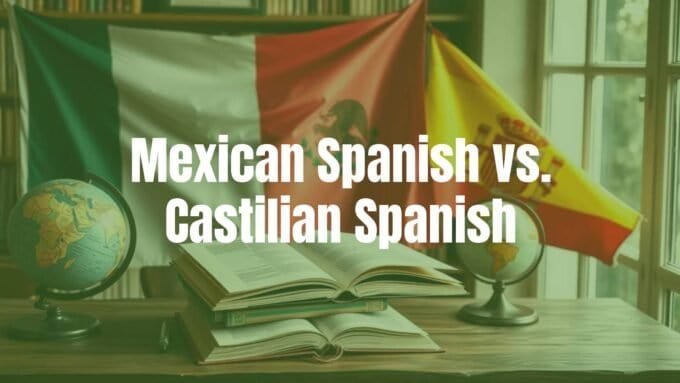Learning Mexican Spanish on the internet gives you access to a lively culture, helps you talk to more people, and brings new chances to communicate. Today, being able to speak another language, especially Spanish, is a useful skill. Choosing to learn the Mexican way of speaking Spanish lets you better understand the culture and connect to a large group of Spanish speakers in Mexico and North America. This article will look at what makes Mexican Spanish unique, why you should learn it online, and show you the different online tools and courses that can help you succeed.

What Makes Mexican Spanish Different?
Mexican Spanish includes all the Spanish spoken in Mexico and also lots in the United States and Canada due to people moving across borders. There are more than 167 million native speakers, with close to 40 million in the U.S. alone. This makes it the most spoken type of Spanish in the United States. The version of Spanish people speak in Mexico grew over time, taking influence from indigenous languages like Nahuatl, and Mexico City played an important role in spreading it through the media.
Although Spanish is the main language in Mexico, different areas have their own accents and ways of speaking. Central Mexico, and especially Mexico City, has an accent most people recognize around the world because many movies and TV shows use this version for their Spanish dubbing. Indigenous languages (over 90 in Mexico) still shape the local ways of speaking and what words people use, making Mexican Spanish very diverse.
Key Differences Between Mexican and European Spanish
When you compare Mexican Spanish with Castilian Spanish (the main type in Spain), you will notice some clear differences. One of the biggest is how the letters ‘z’ and ‘c’ (when in front of ‘e’ or ‘i’) are pronounced. In Spain, there is often a ‘th’ sound, while in Mexican (and most American) Spanish, they sound like an ‘s’. This is usually the first difference learners spot.
Another big difference is in using ‘vosotros’. In Spain, ‘vosotros’ is for informal groups (the plural “you”), but in Mexican Spanish (and most of Latin America), ‘ustedes’ is used for both formal and informal groups. This makes verb patterns a bit easier when learning Mexican Spanish. There are also differences in vocabulary, grammar, and common sayings which give each Spanish-speaking region its own “personality”.

Regional Words, Pronunciation, and Common Sayings
Mexican Spanish includes many unique local words, ways of speaking, and lots of slang. For example, ‘carro’ means ‘car’ in Mexico, while in Spain ‘coche’ is used. Likewise, ‘computadora’ is used for ‘computer’ in Mexico, but ‘ordenador’ in Spain. These small differences show how Mexico’s culture shapes its language.
How people speak changes from region to region in Mexico. In the Yucatán, for example, the Spanish sounds different and uses some Mayan words. Coastal areas like Veracruz sound more like Caribbean Spanish. Indigenous languages like Nahuatl have left their mark on central Mexican speech. To sound natural, it’s helpful to learn some common phrases like ‘qué onda’ (what’s up?) and ‘chido’ (cool).
Why Learn Mexican Spanish Online?
Studying Mexican Spanish on the internet brings lots of benefits. Online learning is popular because you can go at your own pace, from anywhere, without needing to go to a classroom. This flexibility means you can fit learning into your schedule, making language learning less stressful and more available to all.
Speaking Mexican Spanish is useful when traveling to Mexico, doing business, or talking with people there or in the U.S. Mexican Spanish is especially important in the United States because so many people use it. If you want to get to know different communities or look for job opportunities, knowing Mexican Spanish is a big plus.
Benefits of Learning Platforms
Learning online gives you:
- Convenience – Learn from anywhere, anytime.
- Self-paced learning – Go as quickly or slowly as you like.
- Access to tutors and other learners worldwide.
- Lots of materials like videos, quizzes, and audio – perfect for all learning styles.

Opportunities for Business, Travel, and Daily Life
Knowing Mexican Spanish can help you:
- Stand out at work, especially if you deal with Spanish-speaking clients.
- Make trips to Mexico more enjoyable and interactive.
- Connect better with friends, neighbors, and enjoy more music, movies, and TV shows.
Netflix and other services have Mexican Spanish shows and films, so learning becomes fun as you watch and listen.
How Do Online Mexican Spanish Courses Work?
Online Mexican Spanish courses use technology to help you learn in flexible ways that suit different learning styles. These courses may have structured lessons, interactive exercises, videos, and live chats with tutors or classmates.
Most online courses mix self-study with live practice. The focus is on real-life communication, not just memorizing words and grammar rules.
Main Types of Courses
- Self-paced courses: Pre-recorded lessons, quizzes, and materials you can do any time. Good for independent learners.
- Live or scheduled sessions: Private lessons or small groups with real teachers, where you can ask questions and get direct feedback.
- Special courses: Some focus on things like business or travel Spanish, or mastering real Mexican phrases and slang.
Self-Paced vs Scheduled Lessons Table
| Type | When | Main Advantages | Main Challenges |
|---|---|---|---|
| Self-Paced | Whenever you want | Flexible, open 24/7, repeat as needed | Needs motivation and discipline |
| Scheduled | Set times | Regular structure, live feedback | Less flexible, might not fit your schedule |

Videos, Podcasts, and Apps
Modern courses use lots of different media:
- Videos: Visual lessons make it easier to understand words and situations. You see and hear native speakers.
- Podcasts: Help you get used to hearing natural Spanish, including everyday talk and dialects.
- Apps: Combine images, games, and sound (e.g., Drops, Memrise, Bluebird) for easy practice.
Personalized Learning and Smart Content
Many courses ask for your level or test you to start where you need. They match lessons to your interests (travel, music, family, etc.) and adjust over time, so you get the most useful practice for your goals.
How to Pick the Right Online Mexican Spanish Course
Choosing the right course online can seem confusing because there are so many. But by keeping a few important things in mind, you can find what fits your needs, goals, and budget.
Important Things to Compare
- Price: Free apps, monthly plans, or private tutoring – choose what you can afford and what feels worth it.
- Flexibility: Decide if you want full control over when you study or prefer set lesson times.
- Features: Look for options like speaking practice, live tutoring, multimedia content, and learning progress tracking.
Matching Your Level
Start with lessons at your real language level. Courses usually have placement tests or let you choose. For beginners, focus on basic grammar, the most-used words, and clear speaking. If you’re more advanced, look for lessons with real sayings, idioms, and in-depth topics.
Certificates and Program Recognition
Some online courses give you a completion certificate. However, most are not official degrees. The real benefit is being able to communicate with people, not just having a paper certificate. If you need proof for work or school, look for courses connected with universities or official Spanish tests like DELE or SIELE.
What Helps You Learn Mexican Spanish Faster Online?
Besides regular courses, other tools can help you learn quicker and make studying more interesting.
Useful Mobile Apps
- Drops: Focuses on common words, has lots of pictures and quick lessons (just 5 minutes/day).
- Memrise: Has thousands of words and lessons, lets you practice with AI speakers and native recordings.
- Bluebird Languages: Videos, spaced repetition for remembering new words.
- Mexican Spanish Basic Phrases: Based on useful everyday situations.
Podcasts and Videos for Listening
- Cheleando con Mextalki: Good for learning slang and real conversation.
- No Hay Tos: Two Mexican teachers talk about language and culture at natural speed.
- How To Spanish: Weekly show about life and topics in Mexico.
- YouTube & Netflix: Watch Mexican shows or movies with or without subtitles to get used to natural voices.

Online Conversation Clubs and Speaking Practice
- Conversation Clubs (like Mextalki): Small groups meet online with a teacher to chat and correct each other.
- One-on-one Tutors (italki, Preply): Personalized practice to help with your particular needs and interests.
- AI Practice Partners: Good for getting comfortable before talking to real people.
Books, Blogs, Vocabulary Tools
- Pocket phrasebooks and dictionaries for Mexican Spanish.
- Books about slang and real-life words, like “Mexislang” or “3,000 Spanish Words and Phrases They Won’t Teach You in School”.
- Dual-language books (Spanish-English) to help you understand context.
- Language learning blogs for tips, grammar help, and cultural information.
Best Ways to Learn Mexican Spanish Online
Just signing up for a course is not enough. Use different methods together for the best results. The most successful learners combine lessons with real practice in listening, speaking, reading, and writing.
Improving Everyday Conversation
- Learn words and phrases you will use every day.
- Don’t be afraid to use Mexican slang and local sayings.
- Practice real-life situations with tutors, friends, or AI partners.
Getting Better at Listening and Pronunciation
- Listen to podcasts and conversations as much as possible.
- Watch Mexican movies and TV, starting with subtitles if needed, and then without.
- Copy how native speakers talk. Record yourself and compare to see what to improve.
Practice Speaking with Native Speakers
- Book online classes with native tutors who can guide you and correct your mistakes.
- One-on-one time lets you focus on your problem areas and build confidence.
- Don’t worry about mistakes. Getting feedback is the fastest way to learn.
Building Useful Vocabulary
- Focus on words you’ll actually use (for eating out, shopping, asking for help, etc.).
- Use flashcard apps or review words in context to remember them better.
- Read Mexican blogs, lyrics, or news articles to see vocabulary in real writing.
Tips to Do Well Learning Mexican Spanish Online
Setting Small, Clear Goals
- Break your learning into smaller targets, like “learn 20 new words this week.”
- Set medium targets, such as “understand half a podcast without subtitles in 2 months.”
- Check your progress and change goals if needed as you get better.
Keep Going and Stay Motivated
- Short, daily practice works better than only occasional big study sessions.
- Mix learning with things you enjoy, like music, TV series, or cooking videos from Mexico.
- Celebrate whenever you reach a goal or understand something new.
Use Community and Get Feedback
- Join online clubs, forums, or social accounts for other Spanish learners.
- Ask teachers and tutors to correct you and give advice.
- Don’t let mistakes stop you-every mistake helps you learn.
Frequently Asked Questions About Learning Mexican Spanish Online
How Long Does It Take to Speak Well?
It depends how often and how you practice, and how much you use your Spanish with real people. Many learners reach “conversational” (B1) level in about 6-12 months with steady, daily practice. Feeling comfortable in most situations can take 1-2 years. It’s most important to practice regularly.
Is It Hard for Beginners?
Mexican Spanish is often one of the easier versions to learn. Its pronunciation is simple, and learning to use ‘ustedes’ for groups keeps grammar easier. If you start with beginner-friendly courses, you’ll get all the basics step by step.
Can I Learn Another Spanish Dialect Later?
Yes. Once you know Mexican Spanish, switching to another type (like Spain’s Spanish) mainly involves picking up some new words, sounds, and a few grammar differences. The basics will stay the same because all Spanish dialects are quite similar.
- Adjust pronunciation (for example, the “th” sound in Spain)
- Learn local terms and expressions
- Pick up new grammar forms (like ‘vosotros’ in Spain)
- Get used to new accents and intonation
What Technology Do I Need?
- Good Internet: For smooth video and audio.
- Computer, tablet, or smartphone: Almost all platforms work on these.
- Webcam: Needed for live lessons.
- Microphone: A headset or built-in mic is fine for speaking practice.
- Headphones: Helps you hear better and blocks noise.
- Updated web browser: (like Chrome or Firefox) keeps things running well.
- Video call programs: Like Zoom or Skype for lessons.
Test your setup before your first lesson to avoid tech issues.














Leave a comment